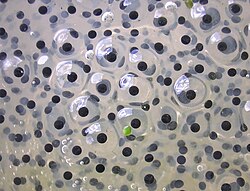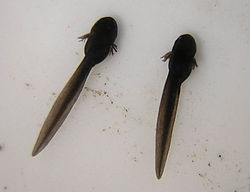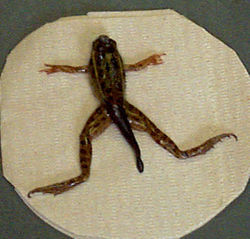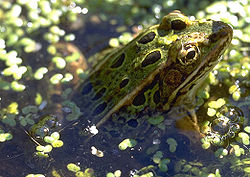|
|
| (455 intermediate revisions by 46 users not shown) |
| Line 1: |
Line 1: |
| − | {{otheruses}}
| + | <noinclude><translate></noinclude> |
| − | {{Taxobox_begin | color = pink | name = Frogs}}
| + | ===Frogs=== <!--T:1--> |
| − | {{Taxobox_image | image = [[Image:Pobblebonk.jpg|250px]] | caption = [[Pobblebonk]], Australia}}
| + | [[Image:Frogspawn closeup.jpg|190px|thumb|Frogspawn]] |
| − | {{Taxobox_begin_placement | color = pink}}
| + | [[Image:Tadpoles 10 days.jpg|190px|thumb||10 days: Tadpoles]] |
| − | {{Taxobox_regnum_entry | taxon = [[Animal|Animalia]]}}
| + | [[Image:Frog-Zhe.jpg||190px|thumb|8–12 weeks: Froglet]] |
| − | {{Taxobox_phylum_entry | taxon = [[Chordate|Chordata]]}}
| + | [[Image:Green-leopard-frog-in-swamp.jpg||190px|thumb|12–16 weeks: Adult frog]] |
| − | {{Taxobox_classis_entry | taxon = [[Amphibia]]}}
| + | The life cycle of frogs, like that of other amphibians, consists of four main stages: egg, tadpole, metamorphosis and adult. The reliance of frogs on an aquatic environment for the egg and tadpole stages gives rise to a variety of breeding behaviors that include the well-known mating calls used by the males of most species to attract females to the bodies of water that they have chosen for breeding. Some frogs also look after their eggs—and in some cases even the tadpoles—for some time after laying. |
| − | {{Taxobox_ordo_entry | taxon = [[Anura]]}}
| |
| − | {{Taxobox_end_placement}}
| |
| − | {{Taxobox_section_subdivision | color = pink | plural_taxon = Suborders}}
| |
| − | [[Archaeobatrachia]]<br />
| |
| − | [[Mesobatrachia]]<br /> | |
| − | [[Neobatrachia]]<br />
| |
| − | - <br /> | |
| − | [[Anura (family list)| Full list of families]]
| |
| − | {{Taxobox_end}}
| |
| | | | |
| − | '''Frog''' is the common name for [[amphibian]]s in the order Anura. There is often a distinction made between frogs and [[toad]]s, based on appearance, however there is no scientific distinction. The only family exclusively given the common name "toad" is [[Bufonidae]], but many species from various other families are also called "toads". "[[True frog]]s" are of the family Ranidae.
| + | <!--T:2--> |
| | + | The life cycle of a frog starts with an egg. Eggs are generally laid in water, and an individual female may lay egg masses containing thousands of eggs. While the length of the egg stage depends on the species and environmental conditions, aquatic eggs generally hatch within one week. |
| | | | |
| | + | <!--T:3--> |
| | + | Some frogs do not have the tadpole stage going from egg to adult shape e.g. New Zealand's native frogs (pepeketua) belong to the genus Leiopelma. |
| | + | Eggs hatch and continue life as tadpoles (occasionally known as polliwogs). Tadpoles are aquatic, lack front and hind legs, and have gills for breathing and tails with fins for swimming. Tadpoles are typically herbivorous, feeding mostly on algae, including diatoms that are filtered from the water through the gills. Some species are carnivorous at the tadpole stage, eating insects, smaller tadpoles and fish. The tadpole stage may be as short as a week, or tadpoles may overwinter and metamorphosis the following year in some species, such as the Midwife toad (''Alytes obstetricans'') and the Common Spadefoot (''Pelobates fuscus''). |
| | | | |
| − | ==Distribution and status==
| + | <!--T:4--> |
| − | Frogs are found nearly worldwide, but they do not occur in [[Antarctica]] and are not present on many oceanic islands.
| + | At the end of the tadpole stage, frogs undergo metamorphosis, in which they transition into adult form. Metamorphosis involves a dramatic transformation of body shape and function, as tadpoles develop hind legs and then front legs, lose their gills and develop lungs. Their intestines shorten as they shift from an herbivorous to a carnivorous diet. The final stage of development from froglet to adult frog involves the loss of the tail. |
| | | | |
| − | In many parts of the world, the [[Decline in frog populations|frog populations have declined]] drastically since the 1950s. Many environmental scientists feel that amphibians, and frogs in particular, may be excellent biological indicators of ecosystem function because of their location on the food web, their permeable skins and their typically bi-phasic life (in both water and on land). Although habitat loss is certainly one of the most important features of most declines; pollutants, climate change, introduction of non-indigenous predators/competitors, and infectious diseases (see [[Chytrid fungus]]) have also been implicated.
| + | <!--T:5--> |
| − | | + | After metamorphosis, young adults may leave the water and disperse into terrestrial habitats, or continue to live in the aquatic habitat as adults. Almost all species of frogs are carnivores as adults, eating invertebrates such as spiders, insects, snails, and slugs. A few of the larger species may eat prey such as small mammals, fish and smaller frogs. Some frogs use their sticky tongues to catch fast-moving prey, while others capture their prey and force it into their mouths with their hands. However, there are a very few species of frogs that primarily eat plants. Adult frogs are themselves preyed upon by birds, large fish, snakes, otters, foxes, badgers, coatis, and other animals. |
| − | [[Image:Dscn1922-frog.jpg|thumb|right|Frog skeleton]]
| + | <br style="clear:both"> |
| − | | + | <noinclude></translate></noinclude> |
| − | | |
| − | | |
| − | ==Diet and Predators==
| |
| − | All adult frogs are [[carnivore]]s, and usually eat invertebrates such as: [[insect]]s, [[worm]]s and [[spider]]s. However, a few of the larger species may eat larger prey, such as small [[mammal]]s, [[fish]] and smaller frogs. Some frogs use their sticky tongues effectively in catching fast-moving prey, while others capture their prey, and force it into their mouth with their hands.
| |
| − | | |
| − | Most tadpoles are [[herbivore]]s, eating moss, or filtering small plant particles through their [[gill]]s. During the process of metamorphosis, their intestine will shorten to accommodate a carnivorous diet. Some species of frogs are carnivorous at the tadpole stage, and will usually eat small larvae and small fish.
| |
| − | | |
| − | Many animals eat frogs. These include [[birds]], large fish, [[snake]]s, [[otter]]s, [[fox]]es, [[badger]]s, [[coati]]s etc. Tadpoles and eggs are predated by fish, newts, predatory diving beetles, and birds such as [[kingfisher]]s. [[Cannibalism]] has also been observed among tadpoles.
| |
| − | | |
| − | ==Taxonomy==
| |
| − | ===Distinction of frogs and toads===
| |
| − | A problem commonly associated with Anurans, is the distinction between frogs and toads. This distinction has no scientific basis, and only refers to the common name of a species. Most frogs in the Ranidae family (true frogs) and Hylidae family (tree frogs) are considered frogs, whereas all those within the Bufonidae family (true toads) are considered toads. However, many families, and even genera, have a mixture of frogs and toads, so there is no taxonomic basis.
| |
| − | | |
| − | The distinction between frogs and toads usually given to the Anurans is; frogs are smooth and moist skinned, while toads have dry, warty skin. An exception can be made for the [[Fire-bellied toad]] (''Bombina bombina''). While its skin is slightly warty, it prefers a watery habitat.
| |
| − | | |
| − | ===Hybridisation===
| |
| − | Many Anurans readily [[hybrid]]ise. For instance, the [[Edible Frog]] (''Rana esculenta'') is a hybrid of the [[Pool Frog]] (''R. lessonae'') and the [[Marsh Frog]] (''R. ridibunda''). ''Bombina bombina'' and ''Bombina variegata'' similarly form hybrids, although these are less fertile, giving rise to a [[hybrid zone]].
| |
| − | | |
| − | ==Frogs in culture==
| |
| − | *[[Frog legs]] are a delicacy in [[China]], [[France]], and in many parts of the [[American South]], especially [[Louisiana]]. The French custom of eating frog legs is the source of the English use of the derogatory nickname "frogs" for French people.
| |
| − | *In the [[Bible]] ([[Exodus]] 8) a [[Plagues of Egypt|plague]] of frogs are sent upon [[Egypt]]
| |
| − | *The behavior of frogs illustrating nonaction is a myth. ("Take a pot of hot water and a frog. Throw the frog into the pot. What do you think will happen? The obvious, of course: the frog will jump out. Who likes hanging around in a pot of hot water? Now ... [t]ake a pot of cold water, put the frog in it, and place the pot on the stove. Turn on the heat. This time something different will occur. The frog, because of the incremental change in temperature, will not notice that it is slowly being boiled." from "Life and Death in the Executive Fast Lane" by Manfred Kets de Vries) Professor Doug Melton, Harvard University Biology Department, says, "If you put a frog in boiling water, it won't jump out. It will die. If you put it in cold water, it will jump before it gets hot -- they don't sit still for you." [http://www.fastcompany.com/online/01/frog.html] A frog put anywhere that doesn't kill it will jump, "they don't sit still for you."
| |
| − | | |
| − | ==Frogs in popular culture==
| |
| − | Frogs feature prominently in [[folklore]] and [[fairy tale|fairy tales]] in many cultures, such as the story of ''[[The Frog Prince]]''. Similarly, numerous [[fantasy]] settings (such as the [[Final Fantasy]] [[videogames]]) include [[spells (paranormal)|magic spells]] that turn people into frogs, such as the [[Frog (Chrono Trigger)| frog]] character in the [[videogame]] [[Chrono Trigger]].
| |
| − | | |
| − | * [[Image:froggunso.JPG|right|200px|thumb|Sgt. Frog (Keroro Gunso)]] '''[[Sgt. Frog]]''' (aka '''Sergeant Keroro''' ['''ケロロ軍曹''' "Keroro Gunsō"], portrayed by [[Kumiko Watanabe]]) is a humorous frog-like alien invader who winds up on Earth in the manga and anime series of the same name created by [[Mine Yoshizaki]] in 2004. Keroro [[licensed product]] merchandise is immensely popular on both sides of the Pacific.
| |
| − | *The [[Crazy Frog]] is a [[cartoon]] creature resembling a frog, the character of the most downloaded ringtone in the [[United Kingdom | UK]].
| |
| − | *Probably the most famous frog in the entertainment world is the [[Muppet]] character [[Kermit the Frog]].
| |
| − | *Until recently, the American TV network The WB ([[Warner Brothers]]) used [[Michigan J. Frog]], a frog in a tuxedo as their logo. Michigan J. Frog was the singing, dancing star of the 1955 Warner cartoon, "[[One Froggy Evening]]".
| |
| − | *''[[Frogger]]'' is an early electronic [[arcade game]] which features a frog that must cross a busy road and river.
| |
| − | *Frogs fall from the sky in various urban myths and notably in the movie [[Magnolia (film)|Magnolia]]. This may derive from incidents when frogs are picked up by a [[tornado]], or when a sudden migration of frogs happens overnight.
| |
| − | *The character [[Jiraiya (Naruto)| Jiraiya]] in the manga/anime series [[Naruto (manga)| Naruto]] calls himself the Frog-Hermit. He has an established blood contract with them and can summon them whenever he chooses.
| |
| − | | |
| − | ==External links==
| |
| − | {{commons|Frog}}
| |
| − | {{cookbook}}
| |
| − | * [http://www-itg.lbl.gov/ITG.hm.pg.docs/Whole.Frog/Whole.Frog.html The Whole Frog Project] - Virtual frog dissection and anatomy
| |
| − | * ''[http://raysweb.net/specialplaces/pages/frogsdecline.html Disappearance of toads, frogs has some scientists worried]'' - ''San Francisco Chronicle'', April 20, 1992
| |
| − | *[http://www.thelilypad.org/ The Lily Pad] - Frog information, care, and culture
| |
| − | * [http://www.racingfrogs.org Racing Frogs Game] - Create, Train, Motivate and Feed your own little froggy friend
| |
| − | * [http://www.frogsonice.com/froggy/ The Froggy Page] - Frog fun
| |
| − | * [http://www.dartden.com Dart Den] - Dart frog resource and forums
| |
| − | * [http://www.xenbase.org/ Xenbase] - A ''Xenopus laevis'' and ''tropicalis'' Web Resource
| |
| − | * [http://markus.nolf.org/blog.php?p=160 Time-lapse video showing the egg's development until hatching]
| |
| − | * [http://www.midwestfrogs.com Frogs]Short video clips of calling frogs and interviews with scientists about frog issues, including declining and malformed frog causes
| |
| − | | |
| − | | |
| − | [[Category:Frogs]]
| |
| − | | |
| − | {{Link FA|eo}}
| |
| − | | |
| − | [[ar:ضفدع]]
| |
| − | [[ast:Xaronca]]
| |
| − | [[bg:Безопашати земноводни]]
| |
| − | [[ca:Granota]]
| |
| − | [[cs:Žáby]]
| |
| − | [[da:Frø (padde)]]
| |
| − | [[de:Froschlurche]]
| |
| − | [[eo:Rano]]
| |
| − | [[es:Rana]]
| |
| − | [[fr:Grenouille]]
| |
| − | [[he:צפרדע]]
| |
| − | [[ja:カエル]]
| |
| − | [[li:Kwakkers]]
| |
| − | [[nl:Kikker]]
| |
| − | [[no:Frosk]]
| |
| − | [[pl:żaba]]
| |
| − | [[pt:Rã]]
| |
| − | [[simple:frog]]
| |
| − | [[sr:Жаба]]
| |
| − | [[sv:Grodor]]
| |
Frogs
The life cycle of frogs, like that of other amphibians, consists of four main stages: egg, tadpole, metamorphosis and adult. The reliance of frogs on an aquatic environment for the egg and tadpole stages gives rise to a variety of breeding behaviors that include the well-known mating calls used by the males of most species to attract females to the bodies of water that they have chosen for breeding. Some frogs also look after their eggs—and in some cases even the tadpoles—for some time after laying.
The life cycle of a frog starts with an egg. Eggs are generally laid in water, and an individual female may lay egg masses containing thousands of eggs. While the length of the egg stage depends on the species and environmental conditions, aquatic eggs generally hatch within one week.
Some frogs do not have the tadpole stage going from egg to adult shape e.g. New Zealand's native frogs (pepeketua) belong to the genus Leiopelma.
Eggs hatch and continue life as tadpoles (occasionally known as polliwogs). Tadpoles are aquatic, lack front and hind legs, and have gills for breathing and tails with fins for swimming. Tadpoles are typically herbivorous, feeding mostly on algae, including diatoms that are filtered from the water through the gills. Some species are carnivorous at the tadpole stage, eating insects, smaller tadpoles and fish. The tadpole stage may be as short as a week, or tadpoles may overwinter and metamorphosis the following year in some species, such as the Midwife toad (Alytes obstetricans) and the Common Spadefoot (Pelobates fuscus).
At the end of the tadpole stage, frogs undergo metamorphosis, in which they transition into adult form. Metamorphosis involves a dramatic transformation of body shape and function, as tadpoles develop hind legs and then front legs, lose their gills and develop lungs. Their intestines shorten as they shift from an herbivorous to a carnivorous diet. The final stage of development from froglet to adult frog involves the loss of the tail.
After metamorphosis, young adults may leave the water and disperse into terrestrial habitats, or continue to live in the aquatic habitat as adults. Almost all species of frogs are carnivores as adults, eating invertebrates such as spiders, insects, snails, and slugs. A few of the larger species may eat prey such as small mammals, fish and smaller frogs. Some frogs use their sticky tongues to catch fast-moving prey, while others capture their prey and force it into their mouths with their hands. However, there are a very few species of frogs that primarily eat plants. Adult frogs are themselves preyed upon by birds, large fish, snakes, otters, foxes, badgers, coatis, and other animals.




